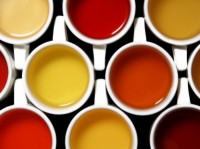|
 There are at least six types of tea: white, yellow, green, oolong, black and pu-erh, of which the most commonly found on the market are white, green, oolong and black (the Chinese call these red teas). All teas are made from the same species of plant, though different varieties may be used, and the leaves are processed differently. There are at least six types of tea: white, yellow, green, oolong, black and pu-erh, of which the most commonly found on the market are white, green, oolong and black (the Chinese call these red teas). All teas are made from the same species of plant, though different varieties may be used, and the leaves are processed differently.
Where does a newcomer begin? How about starting with the one plant that produces every tea in the world?
The Camellia sinensis is an evergreen native of China. It takes a variety of forms, growing 15 to 20 meters tall, with leaves ranging from smooth and shiny to fuzzy and white-haired. The plant gives rise to more than 3,000 varieties of tea worldwide, of which there are basically 6 types, of which the 4 most commonly found on the market are:
White tea
White tea is the rarest of all tea types. A specialty of Fujian province on China's east coast, it was relatively hard to come by outside of China until recently. The name comes from the almost colorless liquor, and from the silvery hairs found on the buds of the plant. White tea consists of the whitish buds of the tea plant; lower quality varieties contain some leaves as well. The buds (and leaves) are naturally dried using either sun drying or steaming methods. This is the final step in the production process, as white tea is unfermented.
Green tea
Green tea makes up approximately ten percent of the world’s tea. The production process, like that of white tea, starts with withering, followed by pan-frying or steaming to prevent fermentation. (The two types differ in that white tea has a higher proportion of buds to leaves.) After steaming and before drying, green tea leaves are rolled to give them the desired shape. In China, this consists of eyebrow-shaped or twisted pieces, tight balls, flat needles, or curled whole leaves. Japanese green tea leaves are shiny green blades with reddish stalks and stems.
Oolong tea
Often referred to as “the champagne of teas,” oolongs are considered to be among the finest – and therefore most expensive - teas in the world. The superior oolongs hail from Taiwan; in China they are also referred to as pouchongs. Oolong tea is “semi-fermented,” meaning that it goes through a short period of oxidation (fermentation). Depending on the degree of fermentation, the liquor varies from pale yellow to amber, with floral or fruity or vegetal quality.
Black tea
Though known to most of the world as “black tea,” the Chinese call it “red tea” due to its characteristic reddish-brown color. Black tea is the most common type of tea worldwide. It has a broad range of flavors, but is typically heartier and more assertive than green or oolong teas. It is made by fully fermenting the harvested leaves (for several hours) before the heating or drying processes occur. This oxidation imparts a dark coloring.
|